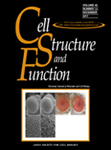
- 2 号 p. 65-
- 1 号 p. 1-
- |<
- <
- 1
- >
- >|
-
Kohei Kawaguchi, Miki Yamamoto-Hino, Yoshiko Murakami, Taroh Kinoshita ...原稿種別: Full Article
2021 年46 巻2 号 p. 65-71
発行日: 2021年
公開日: 2021/09/03
[早期公開] 公開日: 2021/06/30ジャーナル オープンアクセス HTML
電子付録Glycosylphosphatidylinositol (GPI)-anchored proteins are post-transcriptionally modified with GPI and anchored to the plasma membrane. GPI is attached to nascent proteins in the endoplasmic reticulum by the GPI transamidase complex, which consists of PIGT, PIGK, GPAA1, PIGU, and PIGS. Of these, PIGK is a catalytic subunit that is unstable without PIGT. This study investigated the pathway by which unassembled PIGK not incorporated into the complex is degraded. We showed that unassembled PIGK was degraded via the proteasome-dependent pathway and that Hrd1 (also known as SYVN1), a ubiquitin ligase involved in the endoplasmic reticulum-associated degradation pathway, was responsible for degradation of unassembled PIGK.
Key words: Glycosylphosphatidylinositol, GPI transamidase complex, protein stability, transamidation, ERAD
抄録全体を表示PDF形式でダウンロード (582K) HTML形式で全画面表示 -
Ilkin Aygün, Takashi S. Miki原稿種別: Mini-review and Review
2021 年46 巻2 号 p. 73-78
発行日: 2021年
公開日: 2021/11/06
[早期公開] 公開日: 2021/09/03ジャーナル オープンアクセス HTMLXRN2 is a 5'-to-3' exoribonuclease that is predominantly localized in the nucleus. By degrading or trimming various classes of RNA, XRN2 contributes to essential processes in gene expression such as transcription termination and ribosome biogenesis. Despite limited substrate specificity in vitro, XRN2 targets a specific subset of RNA by interacting with other proteins in cells. Here we review the functions of proteins that have an evolutionarily conserved XRN2-binding domain, XTBD. These proteins modulate activity of XRN2 by stabilizing it, controlling its subcellular localization or recruiting it to specific RNA targets, and thereby impact on various cellular processes.
Key words: RNA regulation, XRN2, XTBD, ribosome biogenesis, subcellular localization
抄録全体を表示PDF形式でダウンロード (501K) HTML形式で全画面表示 -
Tetsuro Izumi原稿種別: Mini-review and Review
2021 年46 巻2 号 p. 79-94
発行日: 2021年
公開日: 2021/11/06
[早期公開] 公開日: 2021/09/04ジャーナル オープンアクセス HTMLThe monomeric GTPase Rab27 regulates exocytosis of a broad range of vesicles in multicellular organisms. Several effectors bind GTP-bound Rab27a and/or Rab27b on secretory vesicles to execute a series of exocytic steps, such as vesicle maturation, movement along microtubules, anchoring within the peripheral F-actin network, and tethering to the plasma membrane, via interactions with specific proteins and membrane lipids in a local milieu. Although Rab27 effectors generally promote exocytosis, they can also temporarily restrict it when they are involved in the rate-limiting step. Genetic alterations in Rab27-related molecules cause discrete diseases manifesting pigment dilution and immunodeficiency, and can also affect common diseases such as diabetes and cancer in complex ways. Although the function and mechanism of action of these effectors have been explored, it is unclear how multiple effectors act in coordination within a cell to regulate the secretory process as a whole. It seems that Rab27 and various effectors constitutively reside on individual vesicles to perform consecutive exocytic steps. The present review describes the unique properties and in vivo roles of the Rab27 system, and the functional relationship among different effectors coexpressed in single cells, with pancreatic beta cells used as an example.
Key words: membrane trafficking, regulated exocytosis, insulin granules, pancreatic beta cells
抄録全体を表示PDF形式でダウンロード (530K) HTML形式で全画面表示 -
Kosuke Nagata, Ken-ichi Bajo, Hideyuki Mitomo, Ryosuke Fujita, Ryota U ...原稿種別: Full Article
2021 年46 巻2 号 p. 95-101
発行日: 2021年
公開日: 2021/11/20
[早期公開] 公開日: 2021/09/25ジャーナル オープンアクセス HTML
電子付録Among the inheritance of cellular components during cell division, deoxyribonucleic acid (DNA) and its condensate (chromosome) are conventionally visualized using chemical tag-labeled nucleotide analogs. However, associated mutagenesis with nucleotide analogs in the visualization of chromosomes is cause for concern. This study investigated the efficiency of using stable isotope labels in visualizing the replicating cultured human cell-chromosomes, in the absence of analog labels, at a high spatial resolution of 100 nm. The distinct carbon isotope ratio between sister chromatids reflected the semi-conservative replication of individual DNA strands through cell cycles and suggested the renewal of histone molecules in daughter chromosomes. Thus, this study provides a new, powerful approach to trace and visualize cellular components with stable isotope labeling.
Key words: stable isotope, chromosome replication, semi-conservative replication, imaging, mass spectrometry
抄録全体を表示PDF形式でダウンロード (624K) HTML形式で全画面表示 -
Taisei Tanaka, Yoshinobu Konishi, Hiroshi Ichise, Shinya Tsukiji, Mich ...原稿種別: Full Article
2021 年46 巻2 号 p. 103-111
発行日: 2021年
公開日: 2021/12/22
[早期公開] 公開日: 2021/11/06ジャーナル オープンアクセス HTML
電子付録IFN-γ secreted from immune cells exerts pleiotropic effects on tumor cells, including induction of immune checkpoint and antigen presentation, growth inhibition, and apoptosis induction. We combined a dual promoter system with an IFN-γ signaling responsive promoter to generate a reporter named the interferon sensing probe (ISP), which quantitates the response to IFN-γ by means of fluorescence and bioluminescence. The integration site effect of the transgene is compensated for by the PGK promoter-driven expression of a fluorescent protein. Among five potential IFN-γ-responsive elements, we found that the interferon γ-activated sequence (GAS) exhibited the best performance. When ISP-GAS was introduced into four cell lines and subjected to IFN-γ stimulation, dose-dependency was observed with an EC50 ranging from 0.2 to 0.9 ng/mL, indicating that ISP-GAS can be generally used as a sensitive biosensor of IFN-γ response. In a syngeneic transplantation model, the ISP-GAS-expressing cancer cells exhibited bioluminescence and fluorescence signals in an IFN-γ receptor-dependent manner. Thus, ISP-GAS could be used to quantitatively monitor the IFN-γ response both in vitro and in vivo.
Key words: in vivo imaging, tumor microenvironment, interferon-gamma, dual promoter system
抄録全体を表示PDF形式でダウンロード (703K) HTML形式で全画面表示
- |<
- <
- 1
- >
- >|